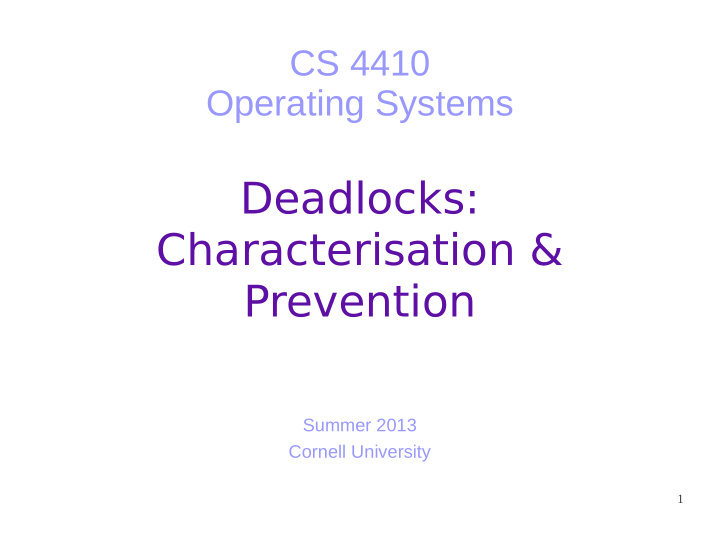



CS 4410 Operating Systems Deadlocks: Characterisation & Prevention Summer 2013 Cornell University 1
Today ● What are the deadlocks and how are they created? ● System Model ● Deadlock examples ● Four conditions for deadlock ● Resource allocation graph ● Deadlock prevention 2
System Model There are non-shared computer resources ● Maybe more than one instance ● Printers, Semaphores, Tape drives, CPU ● Processes need access to these resources ● Acquire resource ● If resource is available, access is granted – If not available, the process is blocked – Use resource ● Release resource ● Undesirable scenario: ● Process A acquires resource 1, and is waiting for resource 2 ● Process B acquires resource 2, and is waiting for resource 1 ● Deadlock! ● 3
Deadlock 4
Deadlock 5
Example 1: Semaphores semaphore: mutex1 = 1 /* protects file */ mutex2 = 1 /* protects printer */ Process B code: Process A code: { { /* initial compute */ /* initial compute */ P(mutex2) P(mutex1) P(mutex1) P(mutex2) /* use file & printer */ /* use file & printer*/ V(mutex1) V(mutex2) V(mutex2) V(mutex1) } } 6
Example 2: Dining Philosophers class Philosopher: chopsticks[N] = [Semaphore(1),…] Def __init__(mynum) self.id = mynum Def eat(): right = (self.id+1) % N left = (self.id-1+N) % N while True: P(left) P(right) # eat V(right) V(left) 7
Deadlock ● A set of processes is in a deadlock state when every process in the set is waiting for an event that can be caused only by another process in the set. ● Events: resource acquisition and resource release ● Resources: physical or logical 8
Four Conditions for Deadlock Necessary conditions for deadlock to exist: ● Mutual Exclusion ● At least one resource must be held in non-sharable mode ● Hold and wait ● There exists a process holding a resource, and waiting for another ● No preemption ● Resources cannot be preempted ● Circular wait ● There exists a set of processes {P1, P2, … PN}, such that ● P1 is waiting for P2, P2 for P3, …. and PN for P1 – All four conditions must hold for deadlock to occur ● 9
Resource-Allocation Graph ● It helps us depict which resources have been assigned to which processes and which processes have requested which resources. ● Directed graph ● Vertices ● P: set of processes ● R: set of resources ● Edges ● Pi → Rj : request edge ● Rj → Pi : assignment edge 10
Resource-Allocation Graph ● If there is a deadlock, then there is a cycle. ● If there is a cycle, then: ● If the involved resources have one instance each, then there is deadlock ● Else a deadlock may not exist R1 R1 P1 P2 P1 P2 R2 P3 R2 11
Handling Deadlocks ● A system never enters a deadlock state. ● Prevention, or ● Avoidance ● A system may enter a deadlock state. ● Detect deadlock ● Recover from deadlock ● Ignore deadlock problem 12
Deadlock Prevention ● Prevention: Negate one of necessary conditions Mutual exclusion: ● Make resources sharable ● Not always possible (printers?) ● Hold and wait ● Do not hold resources when waiting for another ● Request all resources before beginning execution ● Processes do not know what all they will need ● Starvation (if waiting on many popular resources) ● Low utilization (Need resource only for a bit) ● Alternative: Release all resources before requesting anything new ● Still has the last two problems – 13
Deadlock Prevention No preemption: ● Make resources preemptable (2 approaches) ● Preempt requesting processes’ resources if all not available – Preempt resources of waiting processes to satisfy request – Good when easy to save and restore state of resource ● CPU registers, memory virtualization – Circular wait: (2 approaches) ● Single lock for entire system? (Problems) ● Impose partial ordering on resources, request them in order ● 14
Today ● What are the deadlocks and how are they created? ● System Model ● Deadlock examples ● Four conditions for deadlock ● Resource allocation graph ● Deadlock prevention 15
Recommend
More recommend